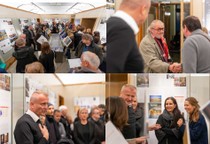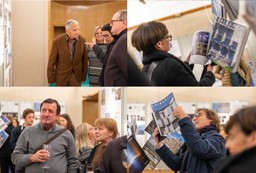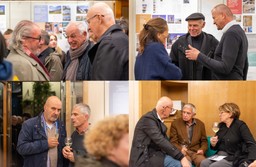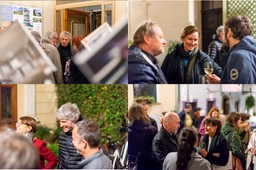
Events
Exhibition PIRANESI 30: 30 Years of Piranesi Magazine
We kindly invite you to the opening of the exhibition
Piranesi 30: 30 Years of Piranesi Magazine
on Monday, 7 November at 7 p.m.,
in DESSA Gallery, Židovska steza 4, Ljubljana, Slovenia.
On the 30th anniversary of the publication of the architectural magazine Piranesi, which raises awareness and indirectly enhances the quality of the Central European cultural space and architecture, the Editorial Board feels called upon to mark this round-number anniversary with an overhauled website, an overview exhibition, and a double-issue of the magazine, which is still also published in the traditional printed format.
The new issue of Piranesi has been refreshed in terms of graphic design, while the concept underlying the content remains similar to that of the last thirty years. In the magazine we keep the focus on Central Europe and a tradition which began in 1983 in Piran and Portorož with the Piran Days of Architecture, and later continued with the giving out of the annual Piranesi Awards, and in June 1992 with the publication of the first issue of the Piranesi magazine.In the subtitle of the magazine, created on the initiative of the now sadly deceased Vojteh Ravnikar and Tomaž Brate, who also brought the designer Ranko Novak into the team, it is clearly highlighted that this was the first Central European architectural magazine for spatial culture. Its concept has remained the same from the outset, and dedicated to the most important architectural works that have been realised in the Central European area. Thus, the cover of the first issue presented the Villa Müller in Prague, by the architect Adolf Loos. The Villa Müller, as one of the architectural icons of 20th century contemporary architecture, was the right choice for the launch of the magazine. The following issue featured Plečnik’s Royal Hunting Lodge in Kamniška Bistrica, the third issue Casa Ottolenghi (Villa Ottolenghi) by architect Carl Scarpa, and the fourth issue presented the Memorial Complex Kampor that was built to mark the concentration camp that was once on the island of Rab, in Croatia, by the architect Edvard Ravnikar.After that, a number of varied masterpieces were presented, including the Urania in Vienna by Max Fabiani,and the Villa Tugendhat in Brno, Czechia, one of the most important works by the architect Ludwig Mies van der Rohe.Last year’s issue focused on Hotel Kanin by the architect Janez Lajovic, while in the latest issue the experimental Steinhaus (Stone House) project by the architect Günther Domenig is presented in-depth, giving readers a closer look at a building which is located only about an hour’s drive from Ljubljana – in Carinthia, Austria – but is one that many Slovenian connoisseurs of architecture have likely not seen with their own eyes yet.
In addition to all the significant, highly recognised and publicised architectural projects presented in Piranesi, a special issue of the magazine was published in 2001 that was dedicated entirely to the oeuvre of Oton Jugovec, one of the most important Slovene architects. It was produced by Maruša Zorec, and in 2018 was reprinted in an updated edition.
In addition to some older highlights of the architecture of 20th century Central Europe, every year Piranesi publishes articles on those works that have won a Piranesi Award at the annual Piran Days of Architecture, which are mostly accompanied by interviews with the winners. With regard to those topics that are closely connected to the Piran Days of Architecture, the magazine offers a wide-ranging presentation of contemporary Central European architecture and production from Slovenia, Italy, Austria, Croatia, Czechia, Slovakia and Hungary – a space that is equated with the term Central Europe as an echo of the former Austro-Hungarian empire. The space which Vojteh Ravnikar, in his editorial to the first issue of Piranesi in 1992, placed in the European centre of our common cultural passe-partout.
In addition to the main themes and contemporary architecture that are presented in each issue, the interviews with architects from the Central European space have always found an important place in the magazine, from Gino Valle, Francesco Dal Co, Vladimir Šlapeta, Branko Silađin, Hrvoje Njirić, Johann Georg Gsteu, Heinz Tesar, and Bernardo Bader, to Slovene architects such as Stanko Kristl, Janez Lajovic, Marko Mušič, Jurij Kobe, Janez Koželj, Peter Gabrijelčič and others. In the latest issue we can add to this impressive list an interview with the architect Janez Kobe, who was the last Slovene who was awarded the Borba Federal Award for Architecture back in the days of Yugoslavia.
A special chapter in the history of Piranesi includes various presentations of Slovene design, with articles, among others, on the Slovene currency that we have almost forgotten about – the tolar, as designed by Miljenko Licul – as well as the imaginative designs of the chairs produced by Janez Suhadolc, and the masterful glass designs of Tanja Pak. And at the end of the main part of the magazine, there has always been some space reserved for reviews of current architectural publications.
The multicultural nature of Piranesi also needs to be emphasised, which is expressed in its multilingualism, as the texts are written in the authors’ mother tongue, but all are also translated into English. In addition to the Slovenian language, readers can thus enjoy contributions and articles in Croatian, German, Italian, Hungarian or Czech, which gives it a special charm and, above all, deepens its links with and engagement in the Central European area.
Although the publication of a double issue of Piranesi takes place only once a year, it is important to note that the magazine brings a critical distance to the consideration of older architecture and a selection of some of the most recent Central European architectural productions in the Slovene and Central European space. And, above all, that it still retains its traditional format of a printed copy, despite the widespread decline, and even demise, of many professional printed publications. We believe that it is important to be able to hold the magazine in one’s hands, to read it, or simply leaf through it, and eventually put it on a shelf and then, in time, take it back into one’s hands, creating an intimate, tactile relationship with readers. That is why we are going to try and keep the magazine in printed format, because as such, if properly archived, it will remain available to posterity.
Finally, let us explain the origin of the magazine’s name – Piranesi. Firstly, the magazine is directly linked to the Piran Days of Architecture, the event which takes place every year in Piran, and secondly, it is also linked to architect Giovanni Battista Piranesi, the well-known 18th-century Italian architect, who is said to have come from a family associated with Piran.
Robert Potokar, Editor-in-Chief of Piranesi
Razstava Piranesi 30 • Exhibition piranesi 30
Koncept in zasnova • Concept and Design
Robert Potokar, Staša Baranja, Matej Fornazarič
Producent • Producer
Ustanova Fundacija Piranesi, DESSA galerija, Obalne galerije Piran • Ustanova Fundacija Piranesi, Dessa Gallery, Piran Coastal Galleries
Oblikovanje in tisk zloženk • Design and printing of leaflets
Mat-Format
Lektura slovenskih besedil • Slovene Editing
Manica Baša
Prevod v angleščino • English Translation
Špela Urbas
Lektura angleških besedil • English Editing
Paul Steed
Tisk plakatov • Poster Printing
Prima IP
Pokrovitelji • Sponsors
Ministrstvo za kulturo RS • Ministry of Culture
Ustanova Fundacija Piranesi, Zumtobel, ACO
Major sponsors of Piranesi magazine 1992 – 2022
STOL d.d. Kamnik, INTERFLOORING skupina d.o.o., MARMOR Sežana d.d., TRIMO d.o.o., Božnar in Partner d.o.o., HIT d.d. Nova Gorica, Alu König Stahl d.o.o., Marmor Hotavlje d.d., IMOS d.d., DDC d.o.o. Ljubljana, Siteco d.o.o., Foto format d.o.o., REFLEX Gornja Radgona d.o.o., Zumtobel, Varis Lendava d.o.o., Fibran d.o.o., KOLPA d.o.o. Metlika, Alpod d.o.o., Knaufinsulation, ATLAS OPREMA d.o.o., CONA plus d.o.o., MAPEI d.o.o. Novo mesto, ACO d.o.o., Xella Porobeton SI d.o.o., Moderna d.o.o., Ravago Building Solutions d.o.o., Arcadia d.o.o., Geberit d.o.o., T-Lotus d.o.o., Roletarstvo Medle d.o.o., Žurbi team d.o.o., Interrier Showroom, Velux d.o.o.
Ljubljana – Piran, november 2022 • Ljubljana – Piran, November 2022



